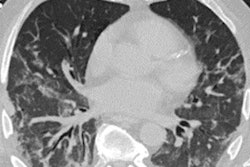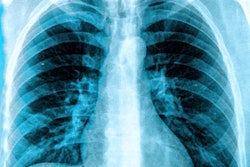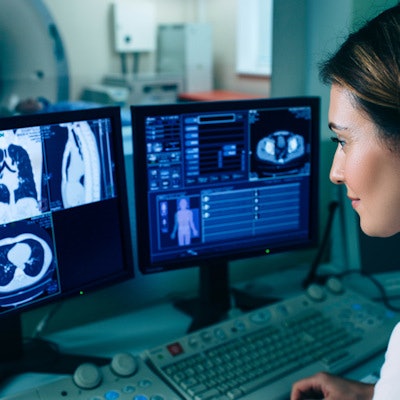
In 2020, the COVID-19 pandemic has shaped the practice of imaging across all modalities, and CT is no exception. At the upcoming RSNA 2020 meeting, attendees are likely to hear significant discussion of how CT fits into the continuum of COVID-19 diagnosis and tracking.
That's according to Dr. Elliot Fishman, director of diagnostic imaging and body CT at Johns Hopkins University in Baltimore.
 Dr. Elliot Fishman.
Dr. Elliot Fishman."Regarding CT, I expect there will be more papers on COVID than anything else, and particularly about using artificial intelligence with CT for COVID," he told AuntMinnie.com.
CT will also have its time in the spotlight for a range of other applications, from combining it with artificial intelligence (AI) to spot pulmonary embolism to distinguishing COVID-19 from electronic cigarette (e-cigarette) or vaping product use-associated lung injury (EVALI). Attendees will also find lively discussion about how to manage CT's radiation dose.
CT and AI
Fishman stressed that CT will play a key role in the development and implementation of AI going forward.
"CT is so critical for AI," he said. "Ninety-five percent of the data used to develop AI comes from CT. The modality has less variability between scanners than, say, MRI and produces huge volumes of data."
 Dr. Seth Kligerman.
Dr. Seth Kligerman.In particular, AI is helping clinicians better identify pulmonary embolism (PE) on CT angiography (CTA) -- and not only from PE studies but also on routine exams, according to Dr. Seth Kligerman, chief of cardiothoracic imaging at University of California, San Diego Health.
In fact, in October, AI software developer Aidoc secured clearance from the U.S. Food and Drug Administration (FDA) for its computer-assisted triage technology for marking incidental pulmonary embolism on CT scans and notifying radiologists about the findings.
AI for CT is also being used for lung density mapping and lung nodule detection, although in the latter area it may still be too sensitive, according to Kligerman.
"There are numerous AI-based tools and applications being developed for cardiothoracic CT, and if these applications are going to be successful, they need to be customizable in regard to each user's preference," he said. "Some users want an algorithm that will be nearly 100% sensitive and are willing to sift through numerous false-positive findings to achieve that goal. Others are willing to give up some degree of sensitivity to reduce the number of false-positive findings. It's hard to find a true 'sweet spot' that will fit for everyone, so these things should be adjustable."
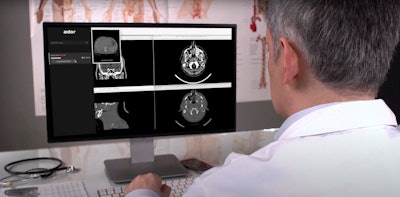 Aidoc's AI algorithm provides flagging and notification of incidental PE found on CT scans. Image courtesy of Aidoc.
Aidoc's AI algorithm provides flagging and notification of incidental PE found on CT scans. Image courtesy of Aidoc.Determining dose
Another ongoing issue in CT is managing radiation dose, according to Madan Rehani, PhD. Rehani is director of global outreach for radiation protection at Massachusetts General Hospital and Harvard Medical School in Boston.
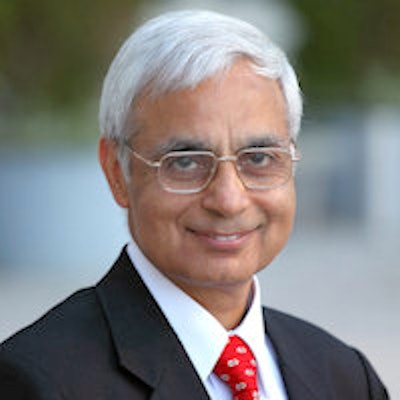 Madan Rehani, PhD.
Madan Rehani, PhD.Patient advocates have long lobbied for the appropriate use of CT in an attempt to spare patients from unnecessary radiation dose, be it from unnecessary CT exams or unoptimized techniques. These efforts have been fairly successful, but there are still patients who need CT for disease diagnosis and management and are being exposed to high levels of radiation.
What's the solution? Developing techniques that enable CT scanners to deliver substantially lower radiation dose, he said.
"For centers that have a system in place to route imaging requests through clinical decision support, dose reduction is not about overutilization but about the capability of the CT machine," he told AuntMinnie.com. "Industry needs to reduce the dose patients get from the CT exam so that patients are able to get the CT exam they need for their care without worrying about radiation risk."
It's important that radiology practices be rewarded for using the lowest doses possible when performing CT, according to Dr. Rebecca Smith-Bindman of the University of California, San Francisco (UCSF). Smith-Bindman directs the Radiology Outcomes Research Laboratory at UCSF and researches radiation dose safety.
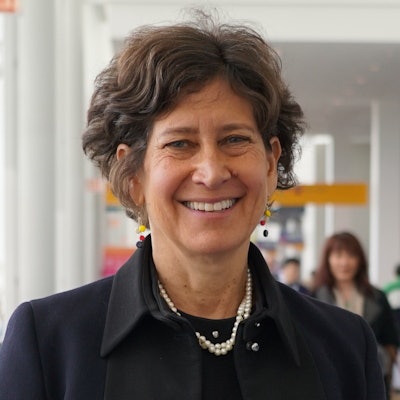 Dr. Rebecca Smith-Bindman.
Dr. Rebecca Smith-Bindman.Under contract with the U.S. Centers for Medicare and Medicaid Services (CMS), Smith-Bindman and colleagues are developing a CT quality measure that imaging centers and hospitals can use in the agency's Merit-Based Incentive Payment System (MIPS) quality payment program that incentivizes high-quality care. It will assign each CT scan to a category based on the body region and image quality required for the indication, then compare the observed radiation dose and image quality with expected values.
The measure will likely be available for reporting in the MIPS program as early as 2022, Smith-Bindman told AuntMinnie.com.
"We hope that physicians who are using the most optimized doses for their patients will be able to successfully complete CMS financial bonuses through reporting on this measure," she said.
Evaluating EVALI
Finally, in the coming year, look for research that explores CT-specific findings that distinguish EVALI from COVID-19, according to Kligerman.
In January, he and a team of colleagues published a study indicating that x-ray followed by CT or CT pulmonary angiography best identifies key imaging patterns indicative of EVALI. The group is now preparing a manuscript that describes the incidence of certain patterns of acute and subacute lung injury with EVALI and explores whether certain imaging findings and patterns are associated with the type of substance vaped, as well as the frequency and duration of vaping.
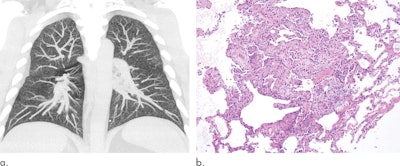 Maximum intensity projections of the CT data of a 32-year-old man with a history of vaping show diffuse centrilobular nodularity (a). Histologic sections of the patient's transbronchial cryobiopsy show a micronodular pattern of airway-centered organizing pneumonia that corresponds to the centrilobular nodularity seen on CT (b). Images courtesy of the RSNA.
Maximum intensity projections of the CT data of a 32-year-old man with a history of vaping show diffuse centrilobular nodularity (a). Histologic sections of the patient's transbronchial cryobiopsy show a micronodular pattern of airway-centered organizing pneumonia that corresponds to the centrilobular nodularity seen on CT (b). Images courtesy of the RSNA."Even during the pandemic, recognizing the imaging patterns associated with EVALI is important," Kligerman told AuntMinnie.com. "While some patterns and imaging findings are nonspecific and can be seen with various causes of lung injury, including COVID-19, there are others that really should make one think of EVALI. This distinction can be quite important as treatments vary depending on the cause of lung injury."
Turbo techniques
CT topics generated the most abstracts among physics-related submissions for RSNA 2020, according to Jerome Liang, PhD, of Stony Brook University Hospital in Stony Brook, NY, and chair of the meeting's physics subcommittee.
Spectral CT is a particularly hot topic, Liang said, as it produces more image texture information than conventional CT imaging and can thus boost the modality's diagnostic performance. In fact, a recent study conducted by a team of French researchers found that spectral CT outperformed conventional CT when it came to early-stage COVID-19 detection.
 A 41-year-old autistic woman with major scoliosis and COVID-19. (A) Initial conventional axial CT image shows no noticeable lung damage (within red box) in right upper lobe. (B) Electron-density spectral CT image obtained at the same time as image A shows lesions (within red box) in the right upper lobe. (C) Follow-up conventional axial chest CT image obtained five days after images A and B confirms the presence of lesions (within red box) in the right upper lobe. Images and caption courtesy of the ARRS.
A 41-year-old autistic woman with major scoliosis and COVID-19. (A) Initial conventional axial CT image shows no noticeable lung damage (within red box) in right upper lobe. (B) Electron-density spectral CT image obtained at the same time as image A shows lesions (within red box) in the right upper lobe. (C) Follow-up conventional axial chest CT image obtained five days after images A and B confirms the presence of lesions (within red box) in the right upper lobe. Images and caption courtesy of the ARRS.Dr. Ferco Berger of Sunnybrook Health Sciences Centre in Toronto likewise believes that research on spectral CT, also known as dual-energy CT, will be prominent.
 Dr. Ferco Berger
Dr. Ferco Berger"I still think there is a lot to optimize and discover with dual-energy CT, and there are actually a fair few papers being submitted with new applications or refining of applications," Berger noted. "Dual-energy technique has evolved quite a bit in the past 10 years, but there's still interest in optimizing it further."
Berger is also chair of the RSNA's emergency radiology subcommittee, and he sees important topics in emergency radiology, with ongoing efforts to reduce radiation dose, contrast dose, and image artifacts. In addition, there will be a continuing focus on iterative reconstruction methods and ultralow-dose CT, according to Berger.
"These [ultralow-dose CT] doses are getting to quite low levels where they are matching x-ray doses," he said.
Also on the horizon is further research on cinematic rendering and vascular imaging using CT angiography, said Fishman of Johns Hopkins.
"In particular, vascular CT is getting better and better, with lower doses necessary," he said. "It offers a good way to predict treatment response."
Programming schedule
Check out the following CT-related sessions at RSNA 2020.
Sunday, November 29
- 10:00 a.m.-11:00 a.m. -- Education Session: Cardiac CT Mentored Case Review: Part I (In Conjunction with the North American Society for Cardiovascular Imaging)
- 10:00 a.m.-11:00 a.m. -- Education Session: Response Assessment on PET/CT
- 3:30 p.m.-4:30 p.m. -- Science Session with Keynote: Chest (COVID-19 Imaging and Lung Infection)
- 5:00 p.m.-6:00 p.m. -- Education Session: Innovations in Dual- and Multienergy CT
Monday, November 30
- 10:00 a.m.-11:00 a.m. -- Education Session: Cardiac CT Mentored Case Review: Part II (In Conjunction with the North American Society for Cardiovascular Imaging)
- 10:00 a.m.-11:00 a.m. -- Science Session: Physics (Spectral/Dual-energy CT)
- 3:30 p.m.-4:30 p.m. -- Education Session: Essentials of Chest Imaging
Tuesday, December 1
- 10:00 a.m.-11:00 a.m. -- Controversy Session: Fractional Flow Reserve CT (CT-FFR) for Indeterminate Stenosis on Coronary CTA -- Should It Replace CT Perfusion?
- 10:00 a.m.-11:00 a.m. -- Science Session with Keynote: Chest (Applications of AI and Radiomics in Lung Imaging)
- 5:00 p.m.-6:00 p.m. -- Education Session: Case-based Review of Thoracic Radiology
Wednesday, December 2
- 8:30 a.m.-9:30 a.m. -- Education Session: Rapid Fire: 80 Cardiac Cases
- 10:00 a.m.-11:00 a.m. -- Hot Topic Session: Chest Findings of COVID-19
Thursday, December 3
- 8:30 a.m.-9:30 a.m. -- Education Session: Case-based Review of Nuclear Medicine: PET/CT Workshop -- Abdomen/Pelvis and Pediatrics (In Conjunction with SNMMI)
- 10:00 a.m.-11:00 a.m. -- Education Session: Peripheral Artery Disease: CTA and MRA
- 10:00 a.m.-11:00 a.m. -- Controversy Session: Triple Rule Out Chest CT in the ER -- Should It Be the 'One Stop Shop' for Chest Pain?
- 2:00 p.m.-3:00 p.m. -- Science Session: Chest (Lung Cancer Screening)
- 3:30 p.m.-4:30 p.m. -- Case-based Review of CT
Friday, December 4
- 8:30 a.m.-9:30 a.m. -- Education Session: Case-based Review of CT
- 10:00 a.m.-11:00 a.m. -- Science Session: Gastrointestinal (Dual-energy CT Technique)
- 3:30 p.m.-4:30 p.m. -- Case-based Review of Nuclear Medicine: PET/CT Workshop -- Advances in PET (In Conjunction with SNMMI)
Saturday, December 5
- 5:00 p.m.-6:00 p.m. -- Education Session: Lung Cancer Screening
- 5:00 p.m.-6:00 p.m. -- Science Session: Gastrointestinal (Dual-energy CT Diagnosis)
All events are listed in Central time.







